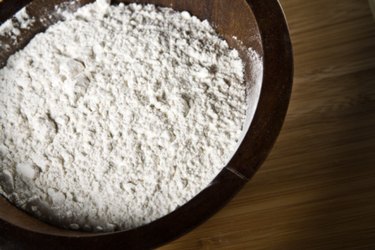Things You'll Need
White, all-purpose flour
Salt
Water
Food coloring
Stew pot
Spoon

Plaster is the base for art projects such as papier mache, modeling projects and sculptures. Though versatile, commercial plaster isn't safe for children and pets that may breathe it or accidentally get it in their mouths. A nontoxic, cost-effective alternative is flour plaster. Not only is flour nontoxic and safe for kids, white flour is available in grocery stores for just a few dollars a pound.
Step 1
Add about 2 cups of flour and ¾ cup of salt to your stew pot. Mix them together thoroughly with a spoon.
Video of the Day
Step 2
Turn the heat on your stew pot to medium and begin adding water to your flour-salt mix. Pour in water about 1/ 2 cup at a time, stirring each in completely before adding the next measurement.
Step 3
Continue adding water to the flour until the mix is the consistency of thick honey. Continue to stir, keeping the tip of the spoon on the bottom of the stew pot to prevent sticking and burning. The flour mix should become translucent.
Step 4
Drip drops of food coloring, if desired, into the translucent plaster. About 10 drops of one color or five drops each of two colors should give the plaster a saturated hue. Incorporate the food coloring completely to avoid marbling.
Step 5
Move the translucent flour plaster to a cool place on the stove. Let it cool for about an hour. Mold and shape as desired or press into molds.
Tip
Paint your finished plaster projects with water colors or tempera paints, and bake them at 375 degrees F for about 10 minutes. Coat them with weather-sealing glaze to prevent mold from excess moisture. Add small pieces of water-soaked paper or bits of straw to your plaster to give it more stability when molded.
Video of the Day